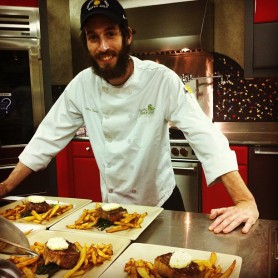by Alex Dunlevie
When faced with the numerous options available today at most mega-marts and butcher shops, some home cooks find themselves overwhelmed and confused. Hopefully this article will shed some light on the basics and help all steak lovers get closer to the steak they desire.
Ribeye
When steak lovers think steak, ribeye is often what they’re thinking of. This isn’t to say it’s the only steak worthy of a steak lover, but It certainly is a classic. Ribeyes come from the rib primal, which gives them an extremely full beefy flavor and an incredible marbling in the meat. This intricate network consisting of veins of beef fat provide ribeyes with richness and a delicious beefiness. A nice layer of fat called the eye surrounds the very center of the steak. This ensures moistness because the fat bastes the steak as it renders during cooking.
Strip
Another top contender is the strip steak (sometimes called the New York Strip) which comes from the “short loin” primal, located behind the Rib primal. Strip steaks are generally slightly more tender than ribeyes, but are also a bit less beefy in flavor. Strip steaks lack the fatty areas that ribeyes possess, but this does not mean that the strip steaks can’t be well marbled in their own right. This isn’t saying that either is better or worse, it’s more of a personal preference.
Tenderloin
Tenderloin is of course the most expensive cut and with fair reason. Tenderloin steaks are extremely tender, but also quite lean. This can be an issue to those less experienced at steak cookery. Tenderloin tends to dry out quickly if over cooked. However, to the experienced cook, tenderloin can yield a phenomenal product. The tenderloin comes from below the short loin primal and under the strip steaks, which extend back behind the sirloin. Tenderloin is also generally the least flavorful of the three major steaks, though it can still achieve wonderful flavor with a little help from the cook.
T-Bone/Porterhouse
T-bones and Porterhouses are effectively cut from the same primal: both are a steak containing both Strip steak and tenderloin. The difference between the two lies in the size of the tenderloin. If the tenderloin piece is wider than 1.25 inches, then it may be called a porterhouse. If it is thinner than 1.25 inches but wider than half an inch, it may be called a T-bone. Steaks where the tenderloin is thinner than half an inch do not qualify for either name, and can be sold as bone-in strip steak or Kansas City Strip.
Sirloin
A sirloin steak comes from behind the short loin, and is the last steak before the round. Sirloins are generally a little tougher than the previously mentioned steaks, but provide big beefy flavor. Sirloin can get tough if cooked past medium/medium rare, but stewing sirloin cubes can yield fantastic results.
Top Sirloin
Also called the coulotte or sirloin strip. This rare find provides an extremely tender, very well marbled, very flavorful steak. This cut hangs below the section of the tenderloin, which extends back behind the sirloin and as a result, does very little work like the tenderloin. The top sirloin is far superior to the other parts of the sirloin, and is comparable to tenderloin in its tenderness. In fact, some prefer the coulotte as its marbling provides good insurance against the steak drying out by overcooking.
Specials:
Flank/Skirt
Flank and skirt steak come from adjacent areas and are often cooked in similar ways. Both do well if marinated and cooked quickly to medium rare and is ideally sliced thin against the grain to aid in the tenderness. Both flank and skirt steak provide great flavor, but rank low in the tenderness category. Neither quite reaches the levels of the previously mentioned steaks. Also, flank and skirt both react well to slow cooking, making them a versatile choice to the meat lover. However, generally skirt steak is more expensive than flank and as such, skirt is more often used for quick high heat applications, while flank is used for slower cooking methods.
Hanger steak
Sometimes called the Butcher’s steak. The hanger is a cut that is not particularly pretty, but delivers excellent beefy flavor. Hanger steak, like Flank and Skirt steak, is best marinated and quickly cooked over high heat, served medium rare, and sliced against the grain. The steak is slightly more tender and flavorful than a Flank or Skirt steak, but still not as spectacular as the more recognized steaks. Hanger steak is still a relatively rare find in the United States, but is gaining popularity slowly.
“Other” “steaks”
Generally, other cuts labeled as steak are poor excuses for steak. This isn’t to say that a flat iron or top round can’t be cooked to excellence, but they generally fail to deliver the blend of beefiness and tenderness that a great steak is prized for. These tougher cuts should be slow cooked for best results. This includes braising, smoking, or any other slow cooking process.
Alex Dunlevie is a sous chef with Savory Celebration hailing from the northern San Francisco Bay area. Alex has been a serious foodie his entire life and staged at restaurants around California including the award winning Michael Mina. While mentoring under Chefs Robbie and Samantha, he was given the skills necessary to further his growth as a chef and hone the finer points of his culinary knowledge. Alex loves cooking protein of all kinds, particularly beef, and is interested in both modern and classic approaches to technique.


